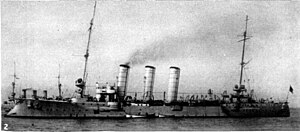SMS Hamburg

An unidentified member of the Bremen class
|
|
| History | |
|---|---|
|
|
|
| Name: | Hamburg |
| Laid down: | 1902 |
| Launched: | 25 July 1903 |
| Commissioned: | 8 March 1908 |
| Out of service: | 1944 |
| Struck: | 31 March 1931 |
| Fate: | Scrapped, 1956 |
| General characteristics | |
| Class and type: | Bremen-class light cruiser |
| Displacement: | 3,651 metric tons (3,593 long tons) |
| Length: | Length overall: 111.1 meters (365 ft) |
| Beam: | 13.3 m (43.6 ft) |
| Draft: | 5.28 m (17.3 ft) |
| Installed power: | 10,000 ihp (7,500 kW) |
| Propulsion: | 2 shafts, 2 Triple-expansion steam engines |
| Speed: | 22 knots (41 km/h; 25 mph) |
| Range: | 4,270 nmi (7,910 km; 4,910 mi) at 12 kn (22 km/h; 14 mph) |
| Complement: |
|
| Armament: |
|
| Armor: | Deck: 80 mm (3.1 in) |
SMS Hamburg ("His Majesty's Ship Hamburg") was the second of seven Bremen-class cruisers of the Imperial German Navy, named after the city of Hamburg. She was begun by AG Vulcan Stettin in Stettin in 1902, launched on 25 July 1903 and commissioned on 8 March 1904. Throughout her over 40-year long career, she served with the Imperial Navy, the Reichsmarine, and the Kriegsmarine. Armed with a main battery of ten 10.5 cm (4.1 in) guns and two 45 cm (18 in) torpedo tubes, Hamburg was capable of a top speed of 22 knots (41 km/h; 25 mph).
Hamburg served with the High Seas Fleet for the first eight years on active duty. For the rest of her career, she served with U-boat flotillas, first as a flagship for the I U-boat Flotilla and later as a barracks ship for U-boat crews during World War I. she returned to fleet duty with the Reichsmarine after the end of the war, but returned to barracks ship duties starting in 1936, though 1944. She was towed to her namesake city in early July 1944 for scrapping, but was sunk by British bombers toward the end of the month. The wreck was raised in 1949 and subsequently dismantled in 1956.
Hamburg was ordered under the contract name "K" and was laid down at the AG Vulcan shipyard in Stettin in 1902 and launched on 25 July 1903, after which fitting-out work commenced. She was commissioned into the High Seas Fleet on 8 March 1904. The ship was 111.1 meters (365 ft) long overall and had a beam of 13.3 m (44 ft) and a draft of 5.28 m (17.3 ft) forward. She displaced 3,651 t (3,593 long tons; 4,025 short tons) at full combat load. Her propulsion system consisted of two triple-expansion engines, designed to give 10,000 indicated horsepower (7,500 kW) for a top speed of 22 knots (41 km/h; 25 mph). The engines were powered by ten coal-fired Marine-type water-tube boilers. Hamburg carried up to 860 tonnes (850 long tons) of coal, which gave her a range of 4,270 nautical miles (7,910 km; 4,910 mi) at 12 knots (22 km/h; 14 mph). She had a crew of 14 officers and 274–287 enlisted men.
...
Wikipedia
